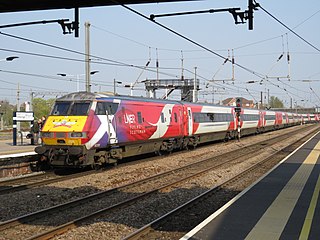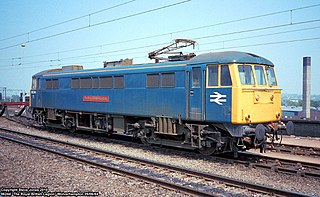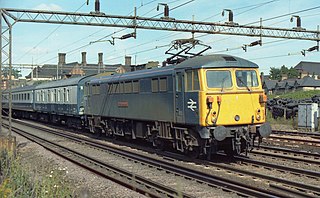

Electric Traction Limited was a British electric locomotive hire company. It operated some former British Rail Class 86 and 87 electric locomotives hired from associated company Europhoenix and the AC Locomotive Group from 2010 until 2019. [1]


Electric Traction Limited was a British electric locomotive hire company. It operated some former British Rail Class 86 and 87 electric locomotives hired from associated company Europhoenix and the AC Locomotive Group from 2010 until 2019. [1]
ETL's first major operation began in 2010 when newly refurbished Class 86/7s, 86701 and 86702, entered traffic on 15 October 2010. Two days later the pair hauled their first revenue-earning train, a private charter for First GBRf from Newcastle to London King's Cross on 17 October. They later went on to work in Winter 2009/2010 on Royal Mail standby services and had several operations as the Network Rail's standby icebreaker locomotives. [1]
By January 2013 there were seven locomotives in the fleet. [2] In 2016, 86213, 86701 and 86702 were sold for further service in Bulgaria. [3] [4]
When Serco, with GB Railfreight contracted to provide traction, took over the Caledonian Sleeper in April 2015, issues arose with the Class 92 locomotives. Electric Traction Limited was contracted to supply 86101, 86401 and 87002, primarily to assist with stock and shunting moves but also to haul services from London Euston to Edinburgh and Glasgow on occasions. [5] These were hired from the AC Locomotive Group. [6] This enabled these locomotives to remain mainline certified and available for occasional charters. With the end of this work in May 2019, the locomotives were returned to the AC Locomotive Group and subsequently sold. [7] [8] [9]

The British Rail Class 89 is a prototype electric locomotive. Only one was built, in 1986, by British Rail Engineering Limited's Crewe Works. It was used on test-trains on both the West Coast and East Coast Main Lines. The locomotive was fitted with advanced power control systems and developed more than 6,000 bhp. After being withdrawn in 1992, it was returned to service in 1996, before being again withdrawn in 2000. As of January 2021, it is in the final stages of an overhaul that will return it to the main line.

InterCity was introduced by British Rail in 1966 as a brand-name for its long-haul express passenger services.

A Driving Van Trailer (DVT) is a British purpose-built control car railway vehicle that allows the driver to operate with a locomotive in push-pull formation from the opposite end of a train. A key benefit of operating trains with DVTs is the requirement for fewer locomotives; for example, a second locomotive would otherwise have to join at the other end of the train after arrival at terminal stations to lead the train's onward journey.

The British Rail Class 86 is a class of electric locomotives built during the 1960s. Developed as a 'standard' electric locomotive from earlier prototype models, one hundred of these locomotives were built from 1965 to 1966 to haul trains on the then newly electrified West Coast Main Line (WCML) from London Euston to Birmingham, Crewe, Liverpool, Manchester and later Glasgow and Preston. Introduction of the class enabled the replacement of many steam locomotives, which were finally withdrawn by British Rail in 1968.

The British Rail Class 73 is a British electro-diesel locomotive. The type is unusual in that it can operate from the Southern Region's 650/750 V DC third-rail or an on-board diesel engine to allow it to operate on non-electrified routes. This makes it very versatile, although the diesel engine produces less power than is available from the third-rail supply so the locomotives are rarely operated outside of the former Southern Region of British Rail. Following the withdrawal and scrapping of the more powerful Class 74 electro-diesels in 1977, the Class 73 was unique on the British railway network until the introduction of the Class 88 electro-diesels in 2017. Ten locomotives have been scrapped.

The British Rail Class 87 is a type of electric locomotive designed and built by British Rail Engineering Limited (BREL) between 1973 and 1975. A total of thirty-six locomotives were constructed, to work passenger and freight services over the West Coast Main Line (WCML).

The British Rail Class 37 is a diesel-electric locomotive. Also known as the English Electric Type 3, the class was ordered as part of the British Rail modernisation plan. They were numbered in two series, D6600–D6608 and D6700–D6999.

The British Rail Class 91 is a high-speed electric locomotive, which produces power of 4,830 kW (6,480 hp); it was ordered as a component of the East Coast Main Line modernisation and electrification programme of the late 1980s. The Class 91s were given the auxiliary name of InterCity 225 to indicate their envisaged top speed of 225 km/h (140 mph); they were also referred to as Electras by British Rail during their development and throughout the electrification of the East Coast Main Line.

The British Rail Class 92 is a dual-voltage electric locomotive, which can run on 25 kV AC from overhead wires or 750 V DC from a third rail. It was designed specifically to operate services through the Channel Tunnel between Great Britain and France. Eurotunnel indicates the Class 92 locomotive as the reference for other locomotives which railway undertakings might want to get certified for usage in the Channel tunnel.

The Class 67 locomotives are a class of Bo-Bo diesel-electric locomotives that were built for the English Welsh & Scottish Railway (EWS) between 1999 and 2000 by Alstom at Meinfesa in Valencia, Spain with drive components from General Motors' Electro-Motive Division.

The British Rail Class 90 electric locomotives were built for mixed-traffic duties, operating from 25 kV AC overhead lines and producing 5,000 bhp (3,700 kW). They weigh 84.5 tonnes and can typically achieve a top speed of 110 mph (177 km/h).

Caledonian Sleeper is the collective name for overnight sleeper train services between London and Scotland, in the United Kingdom. It is one of only two currently operating sleeper services on the railway in the United Kingdom, the other being the Night Riviera which runs between London and Penzance.

GB Railfreight (GBRf) is a rail freight company in the United Kingdom. As of 2022, it is owned by the global investment company Infracapital.
Colas Rail is a railway infrastructure and rail freight company primarily active in the United Kingdom. It is a subsidiary of the French industrial group Bouygues.

The AC Locomotive Group is a dedicated AC electric locomotive preservation society in England. It has five locomotives in its care; 81002, 82008, 83012, 85101 and 89001.

ScotRail has been the brand name used for all Scottish regional and commuter rail services, including some cross-border services, since September 1983, as well as many of the country's intercity services.

The British Rail Mark 5 is the designation given to locomotive-hauled rail carriages built by Spanish manufacturer CAF for operation with Caledonian Sleeper.

UK Rail Leasing (UKRL) is a railway company offering locomotive leasing and rolling stock engineering services to various train operating companies. It is based in Leicester.

Europhoenix is a spot-hire railway locomotive company in England. In addition to the hiring out of locomotives to various other operators across the United Kingdom, it commonly exports former British Rail rolling stock to operators in mainland Europe.
Rail Operations Group (ROG) specialises in ad-hoc movement of rolling stock for rolling stock companies and train operating companies as well as locomotive spot hire services and the operation of charter trains. It has its headquarters and main offices based in Derby.
![]() Media related to Electric Traction Limited at Wikimedia Commons
Media related to Electric Traction Limited at Wikimedia Commons